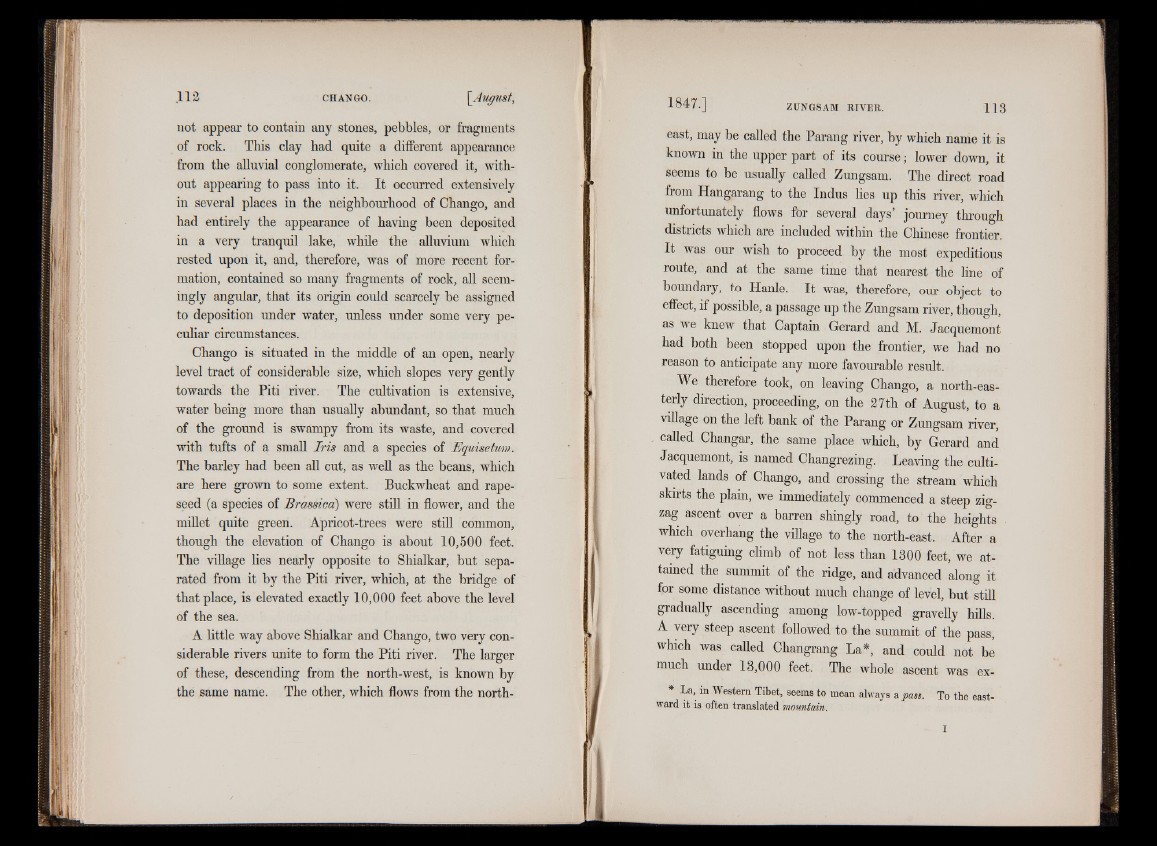
not appear to contain any stones, pebbles, or fragments
of rock. This clay had quite a different appearance
from the alluvial conglomerate, which covered it, without
appearing to pass into it. It occurred extensively
in several places in the neighbourhood of Chango, and
had entirely the appearance of having been deposited
in a very tranquil lake, while the alluvium which
rested upon it, and, therefore, was of more recent formation,
contained so many fragments of rock, all seemingly
angular, that its origin could scarcely be assigned
to deposition under water, unless under some very peculiar
circumstances.
Chango is situated in the middle of an open, nearly
level tract of considerable size, which slopes very gently
towards the Piti river. The cultivation is extensive,
water being more than usually abundant, so that much
of the ground is swampy from its waste, and covered
with tufts of a small Iris and a species of EqvAsetum.
The barley had been all cut, as well as the beans, which
are here grown to some extent. Buckwheat and rape-
seed (a species of Brassica) were still in flower, and the
millet quite green. Apricot-trees were still common,
though the elevation of Chango is about 10,500 feet.
The village lies nearly opposite to Shialkar, but separated
from it by the Piti river, which, at the bridge of
that place, is elevated exactly 10,000 feet above the level
of the sea.
A little way above Shialkar and Chango, two very considerable
rivers unite to form the Piti river. The larger
of these, descending from the north-west, is known by
the same name. The other, which flows from the northeast,
may be called the Parang river, by which name it is
known in the upper part of its course \ lower down, it
seems to be usually called Zungsam. The direct road
from Hangarang to the Indus lies up this river, which
unfortunately flows for several days’ journey through
districts which are included within the Chinese frontier.
It was our wish to proceed by the most expeditious
route, and at the same time that nearest the line of
boundary, to Hanle. It was, therefore, our object to
effect, if possible, a passage up the Zungsam river, though,
as we knew that Captain Gerard and M. Jacquemont
had both been stopped upon the frontier, we had no
reason to anticipate any more favourable result.
We therefore took, on leaving Chango, a north-easterly
direction, proceeding, on the 27th of August, to a
village on the left bank of the Parang or Zungsam river,
called Changar, the same place which, by Gerard and
Jacquemont, is named Changrezing. Leaving the cultivated
lands of Chango, and crossing the stream which
skirts the plain, we immediately commenced a steep zigzag
ascent over a barren shingly road, to the heights
which overhang the village to the north-east. After a
very fatiguing climb of not less than 1300 feet, we attained
the summit of the ridge, and advanced along it
for some distance without much change of level, but still
gradually ascending among low-topped gravelly hills.
A very steep ascent followed to the summit of the pass,
which was called Changrang La*, and could not be
much under 13,000 feet. The whole ascent was ex-
* La, in Western Tibet, seems to mean always a pass. To the eastward
it is often translated mountain.